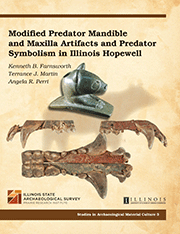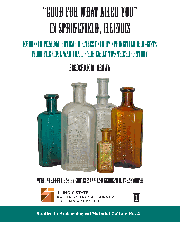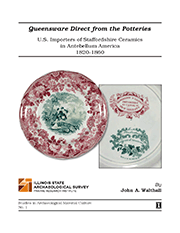Studies in Archaeological Material Culture
 Vol. 3: Modified Predator Mandible and Maxilla Artifacts and Predator Symbolism in Illinois Hopewell
Vol. 3: Modified Predator Mandible and Maxilla Artifacts and Predator Symbolism in Illinois Hopewell
Author: Kenneth B. Farnsworth, Terrance J. Martin, and Angela R. Perri
2019 (reprint), 78 pp. with full-color illustrations, figures, tables, references
Please see our price list to purchase our publications.
Species reidentification and burial-context analysis of 34 artifacts made from the cut-and-drilled mandibles and maxillae of coyotes, wolves, cougars, and bears recovered from Illinois Hopewellian mounds over the past century provide new perspectives on the variety of forms, mortuary associations, species-specific uses, and symbolic significance of these artifacts.
 Vol. 2: “Good for What Ailed You” in Springfield, Illinois: Embossed Pharmaceutical Bottles Used by Springfield Druggists from the Civil War Era to the Early Twentieth Century
Vol. 2: “Good for What Ailed You” in Springfield, Illinois: Embossed Pharmaceutical Bottles Used by Springfield Druggists from the Civil War Era to the Early Twentieth Century
Author: Frederick M. Brown with Introductions by Curtis Mann and Kenneth B. Farnsworth
2015, 440 pp. with full-color illustrations
 This is available only as a PDF. Click here to download.
This is available only as a PDF. Click here to download.
This study deals with Springfield druggists, their locations, and the Springfield druggist bottle collection. Curtis Mann gives a look at Springfield from its beginning in 1821 to the turn of the twentieth century. Kenneth Farnsworth discusses the chronology of pharmacy glassware manufacturing companies and patented bottle styles and shows the changes in manufacturing technology of embossed pharmacy bottles from 1840 to 1925, plus the development of the neighborhood drugstores in Springfield and the disposal patterns of embossed pharmacy bottles.
 Vol. 1: Queensware Direct from the Potteries:
Vol. 1: Queensware Direct from the Potteries:
U.S. Importers of Staffordshire Ceramics in Antebellum America 1820–1860
Author: John A. Walthall
2013, 353 pp. with full-color illustrations
This study was conceived by archaeologists and therefore is biased toward those importers who left tangible evidence of their existence. In this case, it is the underglaze marks on ironstone, and other high-fired pottery, which is almost indestructible when buried. This volume was updated August 1, 2015.
 This is available only as a PDF. Click here to download.
This is available only as a PDF. Click here to download.
Return to top
Publications